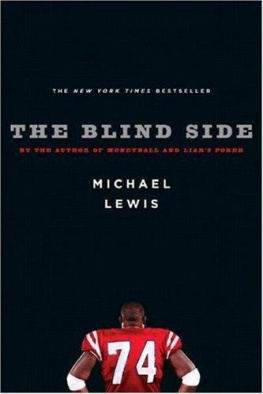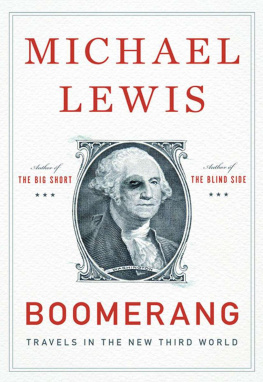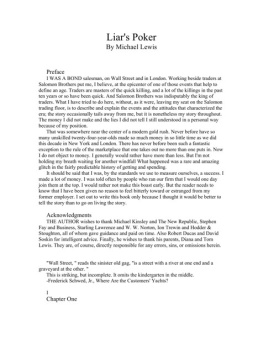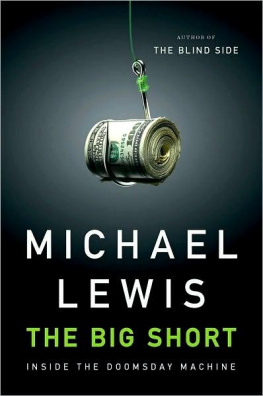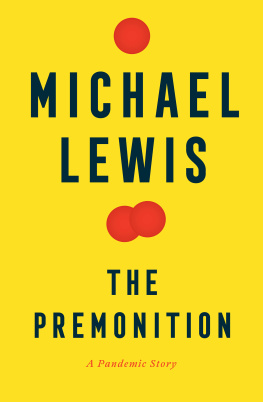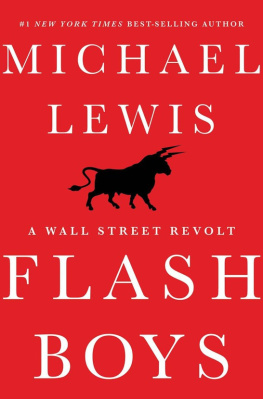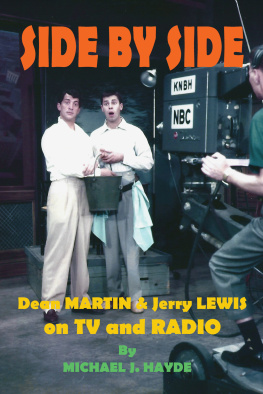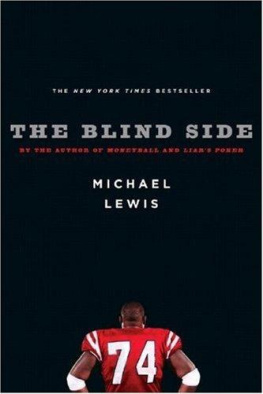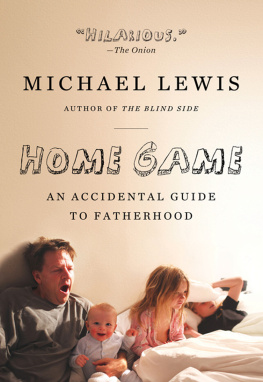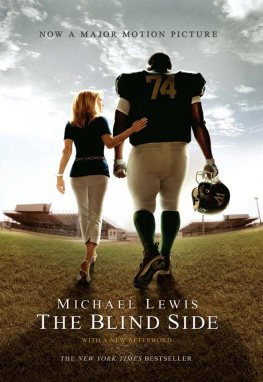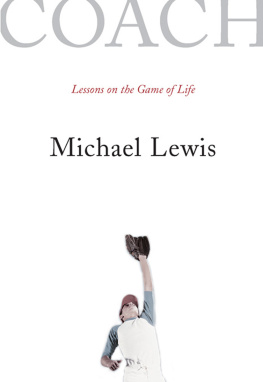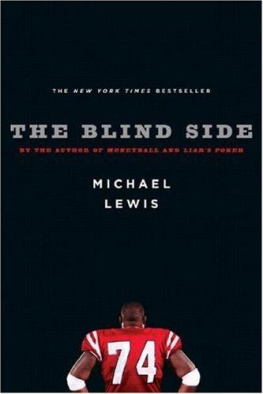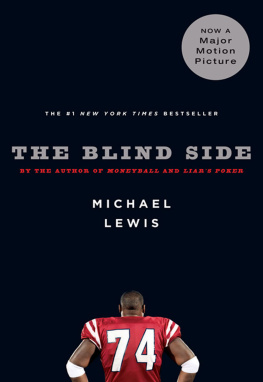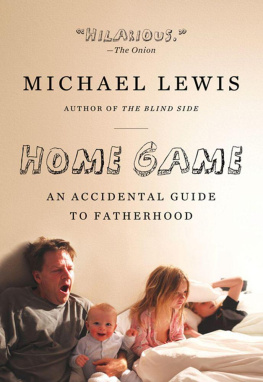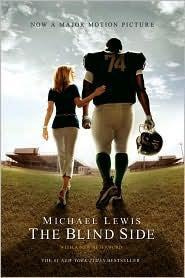Michael Lewis - The Blind Side : Evolution of a Game
Here you can read online Michael Lewis - The Blind Side : Evolution of a Game full text of the book (entire story) in english for free. Download pdf and epub, get meaning, cover and reviews about this ebook. year: 2007, publisher: W. W. Norton & Company, genre: Science. Description of the work, (preface) as well as reviews are available. Best literature library LitArk.com created for fans of good reading and offers a wide selection of genres:
Romance novel
Science fiction
Adventure
Detective
Science
History
Home and family
Prose
Art
Politics
Computer
Non-fiction
Religion
Business
Children
Humor
Choose a favorite category and find really read worthwhile books. Enjoy immersion in the world of imagination, feel the emotions of the characters or learn something new for yourself, make an fascinating discovery.
- Book:The Blind Side : Evolution of a Game
- Author:
- Publisher:W. W. Norton & Company
- Genre:
- Year:2007
- Rating:5 / 5
- Favourites:Add to favourites
- Your mark:
- 100
- 1
- 2
- 3
- 4
- 5
The Blind Side : Evolution of a Game: summary, description and annotation
We offer to read an annotation, description, summary or preface (depends on what the author of the book "The Blind Side : Evolution of a Game" wrote himself). If you haven't found the necessary information about the book — write in the comments, we will try to find it.
The Blind Side : Evolution of a Game — read online for free the complete book (whole text) full work
Below is the text of the book, divided by pages. System saving the place of the last page read, allows you to conveniently read the book "The Blind Side : Evolution of a Game" online for free, without having to search again every time where you left off. Put a bookmark, and you can go to the page where you finished reading at any time.
Font size:
Interval:
Bookmark:
The Blind Side
CHAPTER ONE
The Blind SideBACK STORYFROM THE SNAP of the ball to the snap of the first bone is closer to four seconds than to five. One Mississippi: The quarterback of the Washington Redskins, Joe Theismann, turns and hands the ball to running back John Riggins. He watches Riggins run two steps forward, turn, and flip the ball back to him. Its what most people know as a flea-flicker, but the Redskins call it a throw back special. Two Mississippi: Theismann searches for a receiver but instead sees Harry Carson coming straight at him. Its a runing downthe start of the second quarter, first and 10 at midfield, with the score tied 77and the New York Giants linebacker has been so completely suckered by the fake that hes deep in the Redskins backfield. Carson thinks hes come to tackle Riggins but Riggins is long gone, so Carson just keeps running, toward Theismann. Three Mississippi: Carson now sees that Theismann has the ball. Theismann notices Carson coming straight at him, and so he has time to avoid him. He steps up and to the side and Carson flies right on by and out of the play. The play is now 3.5 seconds old. Until this moment it has been defined by what the quarterback can see. Now itand heis at the mercy of what he cant see.You dont think of fear as a factor in professional football. You assume that the sort of people who make it to the NFL are immune to the emotion. Perhaps they dont mind being hit, or maybe they just dont get scared; but the idea of pro football players sweating and shaking and staring at the ceiling at night worrying about the next days violence seems preposterous. The head coach of the Giants, Bill Parcells, didnt think it preposterous, however. Parcells, whose passion is the football defense, believed that fear played a big role in the game. So did his players. Theyd witnessed up close the response of opposing players to their own Lawrence Taylor.The tackle who had just quit the Philadelphia Eagles, for instance. Jerry Sisemore had played tackle in the NFL for eight years when, in 1981, Taylor arrived. Sisemore played on the right side of the offensive line and Taylor usually came off the other end, but Sisemore still had to worry about the few times Taylor lined up across from him. Their teams were in the same NFL division and met twice each regular season. The week leading up to those games, Sisemore confessed, unnerved him. Towards the middle of the week something would come over you and youd just start sweating, he told the New York Times. My last year in the league, opening day, he immediately got past me. He just looked at me and laughed. Right there I thought I had to get out of this game. And after that season, 1984, he did.The feelings of those assigned to prevent Taylor from hurting quarterbacks were trivial compared to those of the quarterbacks he wanted to hurt. In Taylors first season in the NFL, no official records were kept of quarterback sacks. In 1982, after Taylor had transformed the quarterback sack into the turning point of a football game, a new official NFL statistic was born. The record books defined the sack as tackling the quarterback behind the line of scrimmage as he attempts to pass. Taylor offered his own definition: A sack is when you run up behind somebody whos not watching, he doesnt see you, and you really put your helmet into him. The ball goes fluttering everywhere and the coach comes out and asks the quarterback, Are you all right? Thats a sack. After his first NFL season Taylor became the only rookie ever named the leagues most valuable defensive player, and he published a treatise on his art. I dont like to just wrap the quarterback, he explained. I really try to make him see seven fingers when they hold up three. Ill drive my helmet into him, or, if I can, Ill bring my arm up over my head and try to axe the sonuvabitch in two. So long as the guy is holding the ball, I intend to hurt him. If I hit the guy right, Ill hit a nerve and hell feel electrocuted, hell forget for a few seconds that hes on a football field.The game of football evolved and here was one cause of its evolution, a new kind of athlete doing a new kind of thing. All by himself, Lawrence Taylor altered the environment and forced opposing coaches and players to adapt. After Taylor joined the team, the Giants went from the second worst defense in the NFL to the third best. The year before his debut they gave up 425 points; his first year they gave up 257 points. They had been one of the weakest teams in the NFL and were now, overnight, a contender. Of course, Taylor wasnt the only change in the New York Giants between 1980 and 1981. There was one other important newcomer, Bill Parcells, hired first to coach the Giants defense and then the entire team. Parcells became a connoisseur of the central nervous system of opposing quarterbacks. The symptoms induced by his sack-happy linebacker included, but were not restricted to: intimidation, lack of confidence, quick throws, nervous feet, concentration lapses, wanting to know where Lawrence is all the time. The players on the Giants defense picked up the same signals. As defensive back Beasley Reece told the New York Times, Ive seen quarterbacks look at Lawrence and forget the snap count. One opposing quarterback, finding himself under the center before the snap and unable to locate Taylor, called a time-out rather than run the playonly to find Taylor standing on the sidelines. I think I saw it more with the quarterbacks in our division, says Giants linebacker Harry Carson. They knew enough to be afraid. But every quarterback had a certain amount of fear when he played us.By his fourth pro season Taylor was not just feeding these fears but feeding off them. They come to the line of scrimmage and the first thing they do is start looking for me, he said. I know, and they know. When theyd find me theyd start screaming: 56 left! 56 left! [Taylor wore No. 56.] So theres this thing I did. After the play was over Id come up behind them and whisper: dont worry where I am. Ill tell you when I get there.A new force in pro football, Taylor demanded not just a tactical response but an explanation. Many people pointed to his unusual combination of size and speed. As one of the Redskins linemen put it, No human being should be six four, two forty-five, and run a four-five forty. Bill Parcells thought Taylors size and speed were closer to the beginning than to the end of the explanation. New York Giants scouts were scouring the country for young men six three or taller, 240 pounds or heavier, with speed. They could be found. In that pool of physical specimens what was preciousfar more precious than an inch, or ten pounds, or one tenth of a secondwas Taylors peculiar energy and mind: relentless, manic, with grandiose ambitions and private standards of performance. Parcells believed that even in the NFL a lot of players were more concerned with seeming to want to win than with actually winning, and that many of them did not know the difference. What they wanted, deep down, was to keep their jobs, make their money, and go home. Lawrence Taylor wanted to win. He expected more of himself on the field than a coach would dare to ask of any player.Parcells accumulated lots of anecdotal evidence in support of his view of Taylors football character. One of his favorites involved these very same Washington Redskins. Joe Gibbs in a game in Giants Stadium basically decided that Taylor wasnt going to make any plays, said Parcells. He put two tight ends on Taylors sidealong with the left tackleand two wide receivers in the slot away from Taylor. This was extreme. An NFL football field is a tightly strung economy. Everything on it comes at a price. Take away from one place and you give to another. Three men blocking Taylor meant two Giants with no one to block them. Taylors effect on the game, which the Giants won, was not obvious but it was nonetheless great. But after the game, Parcells continued:The press sees that Lawrence doesnt have a sack and hasnt made a tackle and theyre all asking me whats the matter with Taylor? The next week we go out to San Diego to play the Chargers. Dan Henning is the coach. He sees the strategy. They do the same thing. Two tight ends on Lawrence, two wide receivers in the slot. Lawrence doesnt get a sack. We win again. But after the game everyone is asking me all over again: whats the matter with Taylor? I grab Lawrence in the locker room and say to him, Im going to change your first name from Lawrence to Whats The Matter With? At practice that next week he was Whats The Matter With? What you doin over there Whats The Matter With? Hey, Whats The Matter With?, how come you arent making plays? By Thursday its not funny to him. And I mean it is really not funny.The next game we have is against the Vikings on Monday Night Football. Tommy Kramer is the quarterback. They dont employ the strategy. He knocks Kramer out of the game, causes two fumbles and recovers one of them. Im leaving the field, walking down the tunnel towards the locker room for the press conference. And out of nowhere thisthing comes and jumps on my back. I didnt know he was coming. He basically knocks me over. Hes still got his helmet on. Sweats still pouring down his face. He comes right up into my face and hollers, I tell you what Coachy, they arent going to ask you Whats The Matter With?!!Parcells believed Taylors greatness was an act of will, a refusal to allow the world to understand him as anything less than great. Thats why I loved him so much, he said. He responded to anything that threatened his status. When in the middle of his career Taylor became addicted to cocaine, Parcells interpreted the problem as a simple extension of the mans character. Lawrence Taylor trusted in one thing, the power of his own will. He assumed that his will could control NFL football games, and that it could also control his own chemical desires.He was right about the NFL games. By November 18, 1985, when the Giants went into Robert F. Kennedy Stadium in Washington, DC, to play the Redskins, opposing teams have taken to lining up their players in new and creative ways simply to deal with him. The Redskins are a case in point. Early in the very first game in which his Redskins had faced this new force, back in 1981, Joe Gibbs had watched Taylor sprint past the blocker as if he wasnt there and clobber Joe Theismann from behind. I was standing there, said Gibbs, and I said, What? Did you see that? Oh Lord. Gibbs had flopped about looking for a solution to this new problem, and had come up with the one back offensea formation, widely imitated in the NFL, that uses one running back instead of two. Until that moment, football offenses had typically used running backs to block linebackers who came charging after quarterbacks. But running backs were smaller, weaker, and, surprisingly often, given their job description, slower than Lawrence Taylor. Lynn Cain, a running back for the Atlanta Falcons, was the first to dramatize the problem. The first time Cain went to block Taylor he went in very low, got up underneath him, and sent Taylor flying head over heels. The next play Cain tried it againand was carried off the field on a stretcher. People figured out very quickly that they couldnt block Lawrence with a running back, Parcells said. Then the question became: who do you block him with? Hence Joe Gibbss first solution: to remove the running back from the game and insert, across the line from Lawrence Taylor, a bigger, stronger tight end. The one back offense.That will be the strategy tonight, but Joe Theismann knows too well its imperfections. Having that extra blocker to help the tackle addressed the problem, Theismann thought, without solving it. Too often Taylor came free. The week of practice leading up to the game had been a seminar on Lawrence Taylor. If you looked at our overhead projector or our chalkboard, said Theismann, all the other Giants players were Xs or Os. Lawrence was the only one who had a number: fifty-six. He was a little red fifty-six and the number was always highlighted and circled. The goal was: lets identify where Lawrence is on every play. Taylor moved around a lot, to confuse the defense, but he and his coach were happiest when he came from his own right side and the quarterbacks left. The big reason I put him over there, said Bill Parcells, is the right side is the quarterbacks blind side, since most quarterbacks are right-handed. And no one wants to get his ass knocked off from the back side. Lawrence Taylor was more succinct: Why the hell would I want to come from where he can see me? But then he added: It wasnt really called the blind side when I came into the league. It was called the right side. It became the blind side after I started knocking peoples heads off.Where Taylor is at the start of the play, of course, isnt the problem. Its where he ends up. When I dropped back, says Theismann, the first thing I still did was to glance over my shoulder to see if he was coming. If he was dropping back in coverage, a sense of calm came over me. If he was coming, I had a sense of urgency.Four Mississippi: Taylor is coming. From the snap of the ball Theismann has lost sight of him. He doesnt see Taylor carving a wide circle behind his back; he doesnt see Taylor outrun his blocker upfield and then turn back down; and he doesnt see the blocker diving, frantically, at Taylors ankles. He doesnt see Taylor leap, both arms over his head, and fill the sky behind him. Theismann prides himself on his ability to stand in the pocket and disregard his fear. He thinks this quality is a prerequisite in a successful NFL quarterback. When a quarterback looks at the rush, he says, his career is over. Theismann has played in 163 straight games, a record for the Washington Redskins. Hes led his team to two Super Bowls, and won one. Hes thirty-six years old. Hes certain he still has a few good years left in him. Hes wrong. He has less than half a second.The game is on ABCs Monday Night Football, and 17.6 million people have tuned in. Frank Gifford is in the booth, flanked by O. J. Simpson and Joe Namath. Theismanns in a lot of trouble, the audience hears Gifford say, just before Taylors arms jackknife Theismanns head to his knees and Taylors torso pins Theismanns right leg to the ground. Four other players, including, oddly, the Redskins John Riggins, pile on. Theyre good for dramatic effect but practically irrelevant. The damage is done by Taylor alone. One hundred and ninety-six pounds of quarterback come to rest beneath a thousand or so pounds of other things. Then Lawrence Taylor pops to his feet and begins to scream and wave and clutch his helmet with both hands, as if in agony.His reaction is a mystery until ABC Sports clarifies the event, by replaying it over and again, in slow motion. Again, well look at it with the reverse angle one more time, says Frank Gifford. And I suggest if your stomach is weak, you just dont watch. People watched; the replay was almost surely better attended than the original play. Doug Flutie was probably a representative viewer. Flutie had just finished a glorious college quarterbacking career at Boston College and started a professional one in the USFL. On the evening of November 18, 1985, he was at home with his mother. She had the football game on; he had other things to do. I heard my mother scream, he told a reporter. And then I saw the replay. It puts fear in your heart and makes you wonder what the heck youre doing playing football.Next page
Font size:
Interval:
Bookmark:
Similar books «The Blind Side : Evolution of a Game»
Look at similar books to The Blind Side : Evolution of a Game. We have selected literature similar in name and meaning in the hope of providing readers with more options to find new, interesting, not yet read works.
Discussion, reviews of the book The Blind Side : Evolution of a Game and just readers' own opinions. Leave your comments, write what you think about the work, its meaning or the main characters. Specify what exactly you liked and what you didn't like, and why you think so.

